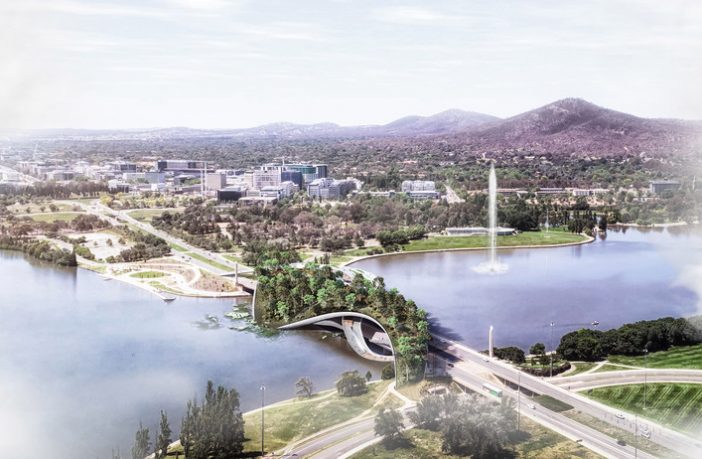CX Landscape has released details of their proposal for the “Ribbons of Life,” a living bridge for Canberra, Australia. Submitted as part of the Remaking Lost Connections design competition organized by the Australian Institute of Landscape Architects (AILA), the scheme sought to create a water axis based on the existing road bridge above Lake Griffin in Canberra city center.
The competition was organized to explore new ideas about future sustainable cities, juggling current natural, cultural, and environmental issues with a focus on climate change, loss of habitat, sustainable lifestyle, and the potential to raise innovative solutions for urban renewal.

The CX scheme centered on creating a forest shell over the existing road bridge between the Parliament House and CBD. Imitating a piece of sample bushland from the natural reserve located in the upper stream of the Molonglo River, the forest continues to cover the concrete shell in an organic form, echoing the green architecture of the Parliament House. Under this shell, existing aboriginal art will be revived by projection on the structure to symbolize lost cultural heritage.
The forest ribbon also serves as a wildlife corridor, connecting parks on the north and south of the lake, varying in width between 30 and 100 meters. The west fringe of the structure extends into the water to become a wetland, providing water access for passengers, while water plants contribute to improving water quality.
The other ribbon is a linear park, an independent structure for people passage. This section will provide educational opportunities in open space, while minimizing the disturbance to wildlife activities. Solar panels are also integrated into paving to generate clean power for the use of luminance, operation, and possible future transport. Key components of the park include a bird observation tower, water-facing plaza, laser projection art, and a water life observation channel.
Landscaping features include windbreak forests on both sides, a nectar meadow, woodland, rocky bushland, and wetland. Rocks and logs are also placed in a natural arrangement to provide shelters along the migration passage.
Our wildlife corridor and the linear park have set an example for the future Garden City Plan action. It gives a new direction for sustainable city development, which raises the awareness of environmental threats, and correct the misconceptions of ‘Green represents Ecology’ and ‘Parks means Ecology’. In respect of nature and local history, reflecting the spirit of the place, our design has established the future direction of sustainable urban development.
-CX Landscape
The design team for the Ribbons of Life comprised of George Zhuo, Jing Peng, Simon Zhao, Danniel Dong, and Annie Huang.
Author: Niall Patrick Walsh
This article was first published in Arch Daily and is republished with minor editorial changes and permission from Arch Daily. Source: CX Landscape

























